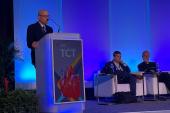More TRILUMINATE Patients Flesh Out Tricuspid TEER’s Impact
The data further confirm the safety and efficacy of the device and add to better understanding of patient selection, researchers say.

Tricuspid-valve transcatheter edge-to-edge repair (TEER) using the TriClip system (Abbott) remains safe and effective in patients with symptomatic severe tricuspid regurgitation (TR), according to new data from the randomized TRILUMINATE Pivotal trial. Moreover, additional insights in a series of nonrandomized patients with more complex anatomies suggest that the device can deliver good results, even in those whose anticipated benefits were more modest.
As reported by TCTMD, the primary endpoint was met for the first 350 randomized patients in the trial, demonstrating a benefit with TEER over medical therapy alone regarding the combination of all-cause death or tricuspid valve surgery, hospitalization for heart failure, and improvement in quality of life according to the Kansas City Cardiomyopathy Questionnaire (KCCQ).
The latest data “strengthen the conclusions” of the original randomized trial, said David H. Adams, MD (Icahn School of Medicine at Mount Sinai, New York, NY), who presented the findings today at TCT 2023. “Our expanded randomized cohort has reinforced our competence that we can significantly reduce tricuspid regurgitation in most patients and that's translating into them feeling better,” he told TCTMD.
“I'm personally very encouraged,” said Pinak Shah, MD (Brigham and Women’s Hospital, Boston, MA), who served as a panelist during a TCT press conference. “I think what we've seen from the single-arm group, which is a more anatomically challenging group, is that we get very good results with it, at least from echo standpoints.”
Whether this procedure is “actually helping patients” remains an open question, he continued. “That's something that we discuss quite a bit, just because of the fact that the major benefit seems to be with quality-of-life scores and this is not a sham-controlled study. In my opinion, I think we have to base that on the safety of the procedure, which is extraordinarily safe. And if you have a patient who really doesn't have a great second option, is it really such a bad thing to offer them a safe procedure that might help them feel better? And I am actually very supportive of it.”
Adams stressed that tricuspid surgery is not offered to increase patient life expectancy, but rather “it's about feeling better and less heart failure hospitalization,” he said. “This is a journey that we've started, and we are all going to continue to learn a lot more about the impact of severe right-sided valvular heart disease. It's very different than left-sided valve disease.”
Randomized, Single-Arm Data
While the initial findings reported on the first 350 randomized patients in TRILUMINATE, the data presented today include an additional 222 patients randomized to either tricuspid TEER or medical therapy alone. It also included the 100 patients from the single arm of the trial who the executive committee originally estimated would see their TR reduced but not to the level of moderate or below; all of these patients received TEER.
Within the entire randomized cohort, mean age was 78.1 years and 59% were female. More than half (55%) were considered to have NYHA III or IV class symptoms, and mean KCCQ score at baseline was 55.1. TR severity in this population was moderate in 2%, severe in 27%, massive in 21%, and torrential in 50%.
Over 12 months, 88% of the study arm reported moderate or less TR, compared with 7% in the control group. Results from the 6-minute walk test were strengthened in the current data, reaching significant benefits in both the imputed and paired analyses in favor of tricuspid TEER. There were no differences in mortality or tricuspid valve surgery as well as heart failure hospitalization at 12 months. KCCQ improvements at 12 months were also similar to that seen in the original analysis with 50% in the study arm reporting at least 15-point improvements compared with 26% of controls. The win ratio for the entire randomized population was 1.53 in favor of tricuspid TEER (P = 0.0042).
In this population, procedural outcomes were similar to those seen in the randomized cohort, and there were no major adverse events within 30 days. Additionally, the researchers saw a comparable sustained TR reduction in this cohort with 81% reporting moderate or less TR at 12 months.
“We weren't very good at predicting which patients weren't going to get good results with the TriClip,” Adams said. “We were under-calling what the ability of this device was to eliminate or to reduce TR in this population.”
Rates of all-cause mortality (15.0% vs 8.6%) and heart failure hospitalization (24.0% vs 14.9%) were slightly higher in the single-arm than in the randomized population at 12 months. Mean KCCQ improvement was comparable with a mean 14.5 point increase, which led to the primary endpoint of 30% performance goal being exceeded for the single-arm cohort (46.2%; P = 0.0008).
Adams stressed the importance of the good safety results seen here to TCTMD. “It would be impossible to duplicate the safety profile of tricuspid TEER therapy versus surgery,” he said. “The safety profile was as extraordinary.”
Expectations
Speaking during the late-breaking clinical science session, Gorav Ailawadi, MD (University of Michigan, Ann Arbor), called attention to the fact that the additional data showed a significant benefit in 6-minute walk test. “Now you have been able to show what we didn't see the first go around,” he said.
However, Ailawadi noted, “the results with functional TR—as most of these patients are with TEER therapies—are not the same with tricuspid as they are with mitral. Obviously, we were overwhelmed by how successful COAPT was. We are not quite seeing that same level of overwhelming success, although we are now starting to see a signal.”
Adams responded that this has all been a learning process. “[Right-sided valve disease] is very different than left-sided valve disease, and we were probably a bit naive in thinking we would see morality benefits at 1 year,” he said. “We don't take a patient to the operating room and promise them they will live longer at 1 year if we do a tricuspid valve operation on them.”
Additionally, he highlighted that current guidelines don’t mention survival as an indication for performing a tricuspid valve intervention. “We've got to sort of start rethinking the expectation for patients that have severe tricuspid regurgitation, particularly in a population like this,” Adams said. “It's been a readjustment for us to think about quality of life and now 6-minute walk test and these sorts of things in this population, but I think they are quite meaningful.”
Next Steps
A major takeaway from the data, both randomized and registry, is that “there is a significant portion of patients with tricuspid valve anatomy, in spite of leads or coaptation gaps or more complex morphology of the tricuspid valve, that can be effectively treated with TriClip,” Adams said. “It certainly will not be all of them, but it's a large percentage of them.”
But whether this is enough to support approval of the device remains to be seen, according to Adams. “From a clinician perspective, I think that for the patient, it is a meaningful benefit,” he told TCTMD.
There's nothing not to like here. Bernard Prendergast
In the press conference, Bernard Prendergast, MD (St Thomas’ Hospital, London, England), highlighted that tricuspid TEER is “a safe treatment, and the endpoints are very similar to those used in heart failure trials. The patient feels better, and their quality of life is improved. There's nothing not to like here.”
David J. Cohen, MD (St. Francis Hospital, Roslyn, NY), who moderated the press conference, noted the significance of the fact that heart failure trials are blinded, however.
Rebecca Hahn, MD (NewYork-Presbyterian/Columbia University Irving Medical Center, New York, NY), who served as a co-investigator of TRILUMINATE, acknowledged during the press conference that when the study was first designed, “we just didn't know as much as we know now. . . . We were trying to figure out what we could do, what we couldn't do.”
She gave the example of more patients with pacemakers included in the single arm of the trial because researchers weren’t sure that these individuals would see as much of a benefit with tricuspid TEER, or indeed, might be higher risk, as has been hinted at with transcatheter tricuspid valve replacement. “These are issues for us when we are trying to determine whether or not to jail a lead with a valve replacement versus allowing the lead to stay in and still function but reduce the amount of tricuspid regurgitation,” she said. “So we've learned so much from the single-arm trial, and I think it's a very powerful result.”
“Had we known what we know today, we might have put everybody into the randomized cohort,” Adams told TCTMD. “It would have been very interesting for the study if we could have predicted that and randomized all patients.”
Next, Adams said his team plans to delve further into the TRILUMINATE data and ultimately present their findings to the US Food and Drug Administration (FDA) early next year. “There is more evidence that we need to continue to look at to really understand the full potential of this therapy, which of course we will then be explaining at the FDA panel,” he said. “And then I think we'll have to take it from there.”
One day, he concluded, “we will have a portfolio of ways to do repair and replacement of the tricuspid valve in these patients, but I think our pool of potential clip candidates has expanded based on the data I have shown you today.”
Yael L. Maxwell is Senior Medical Journalist for TCTMD and Section Editor of TCTMD's Fellows Forum. She served as the inaugural…
Read Full BioSources
Adams DH. TRILUMINATE pivotal: outcomes of all randomized and the single-arm subjects with transcatheter tricuspid valve edge-to-edge repair for tricuspid regurgitation. Presented at: TCT 2023. October 24, 2023. San Francisco, CA.
Disclosures
- The Icahn School of Medicine at Mount Sinai receives royalties from Edward Lifesciences and Medtronic related to Dr. Adams’s intellectual property related to mitral and tricuspid valve repair rings.






Comments